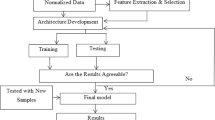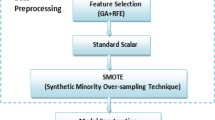Abstract
Discretization and attribute reduction are two preprocessing steps for most of the induction algorithms. Discretization before attribute reduction will result in high computation cost as many irrelevant and redundant attributes need to be discretized. Attribute reduction before discretization may result in over-fitting of the data leading to low performance of the induction algorithm. In this paper, we have proposed a hybrid algorithm using artificial bee colony (ABC) algorithm and extended forward tentative selection with backward propagation of selection decision (EFTSBPSD) algorithm for attribute reduction on real-valued data in rough set theory (RST). Based on the principle of indiscernibility, the hybrid ABC–EFTSBPSD algorithm performs discretization and attribute reduction together. The hybrid ABC–EFTSBPSD algorithm takes as input the decision system consisting of real-valued attributes and determines a near optimal set of irreducible cuts. Here, optimality of the set of irreducible cuts is defined in terms of the cardinality of the set of irreducible cuts. Reduct is obtained from the determined approximate optimal set of irreducible cuts by extracting the attributes corresponding to the cuts in the obtained set of irreducible cuts. The proposed hybrid algorithm is tested on various data sets from University of California Machine Learning Repository. Experimental results obtained by the proposed hybrid algorithm are compared with those obtained by the Q-MDRA, ACO-RST and IMCVR algorithms described in the literature and found to give better classification accuracy when tested using (1) C4.5 classifier and (2) SVM classifier. The proposed hybrid algorithm has also shown reduced length of the reduct in comparison with the results obtained by Q-MDRA, ACO-RST and IMCVR algorithms.

Similar content being viewed by others
References
Alcalá-Fdez J, Fernández A, Luengo J, Derrac J, García S, Sánchez L, Herrera F (2011) KEEL data-mining software tool: data set repository, integration of algorithms and experimental analysis framework. Mult Valued Logic Soft Comput 17:255–287
Bhatt RB, Gopal M (2005) On fuzzy-rough sets approach to feature selection. Pattern Recognit Lett 26(7):965–975
Chebrolu S, Sanjeevi SG (2015) Attribute reduction on continuous data in rough set theory using ant colony optimization metaheuristic. In: Proceedings of the third international symposium on women in computing and informatics, WCI ’15, pp 17–24, ACM, New York, 2015
Chebrolu S, Sanjeevi SG (2015) Forward tentative selection with backward propagation of selection decision algorithm for attribute reduction in rough set theory. Int J Reason Based Intell Syst 7(3/4):221–243
Cornelis C, Jensen R, Hurtado G, Ślȩzak D (2010) Attribute selection with fuzzy decision reducts. Inf Sci 180(2):209–224
Cristianini N, Shawe-Taylor J (2000) An introduction to support vector machines: and other kernel-based learning methods. Cambridge University Press, New York
Dai J, Xu Q (2013) Attribute selection based on information gain ratio in fuzzy rough set theory with application to tumor classification. Appl Soft Comput 13(1):211–221
Friedman M (1940) A comparison of alternative tests of significance for the problem of \(m\) rankings. Ann Math Stat 11(1):86–92
Gao KZ, Suganthan PN, Chua TJ, Chong CS, Cai TX, Pan QK (2015) A two-stage artificial bee colony algorithm scheduling flexible job-shop scheduling problem with new job insertion. Expert Syst Appl 42(21):7652–7663
Guan Y-Y, Wang H-K, Wang Y, Yang F (2009) Attribute reduction and optimal decision rules acquisition for continuous valued information systems. Inf Sci 179(17):2974–2984
Hu Q, Liu J, Yu D (2008) Mixed feature selection based on granulation and approximation. Knowl Based Syst 21(4):294–304
Hu Q, Yu D, Liu J, Wu C (2008) Neighborhood rough set based heterogeneous feature subset selection. Inf Sci 178(18):3577–3594
IBM Corp (2013) IBM SPSS Statistics for Windows, Version 22.0. IBM Corp, Armonk
Jensen R, Shen Q (2004) Fuzzy-rough attribute reduction with application to web categorization. Fuzzy Sets Syst 141(3):469–485
Jia X, Liao W, Tang Z, Shang L (2013) Minimum cost attribute reduction in decision-theoretic rough set models. Inf Sci 219:151–167
Jiang F, Sui Y (2015) A novel approach for discretization of continuous attributes in rough set theory. Knowl Based Syst 73:324–334
Jun Z, Zhou Y (2009) New heuristic method for data discretization based on rough set theory. J China Univ Posts Telecommun 16(6):113–120
Karaboga D (2005) An idea based on honey bee swarm for numerical optimization. Technical Report TR06, Erciyes University, October 2005
Karaboga D (2010) Artificial bee colony algorithm. Scholarpedia 5(3):6915
Karaboga D, Akay B (2009) A comparative study of artificial bee colony algorithm. Appl Math Comput 214(1):108–132
Karaboga D, Basturk B (2008) On the performance of artificial bee colony (ABC) algorithm. Appl Soft Comput 8(1):687–697
Karaboga D, Akay B, Ozturk C (2007) Artificial bee colony (ABC) optimization algorithm for training feed-forward neural networks. In: Torra V, Narukawa Y, Yoshida Y (eds) Modeling decisions for artificial intelligence: 4th international conference, MDAI 2007, Kitakyushu, Japan, August 16–18, 2007. Proceedings, pp 318–329
Kent ridge bio-medical data set repository. http://sdmc.lit.org.sg/gedatasets/datasets.html
Komorowski J, Pawlak Z, Polkowski L, Skowron A (1999) Rough sets: a tutorial. In: Pal SK, Skowron A (eds) Rough fuzzy hybridization: a new trend in decision-making. Springer, Singapore, pp 3–98
Li M, Deng SB, Feng S, Fan J (2011) An effective discretization based on class-attribute coherence maximization. Pattern Recognit Lett 32(15):1962–1973
Li M, Shang C, Feng S, Fan J (2014) Quick attribute reduction in inconsistent decision tables. Inf Sci 254:155–180
Lichman M (2013) UCI machine learning repository. School of Information and Computer Sciences, University of California, Irvine. http://archive.ics.uci.edu/ml
Mac Parthaláin N, Jensen R (2013) Unsupervised fuzzy-rough set-based dimensionality reduction. Inf Sci 229:106–121
Mac Parthaláin N, Shen Q (2009) Exploring the boundary region of tolerance rough sets for feature selection. Pattern Recognit 42(5):655–667
Pawlak Z (1982) Rough sets. Int J Comput Inf Sci 11:341–356
Pawlak Z (2002) Rough set theory and its applications. J Telecommun Inf Technol 3:7–10
Pawlak Z, Skowron A (2007a) Rough sets and boolean reasoning. Inf Sci 177(1):41–73
Pawlak Z, Skowron A (2007b) Rough sets: some extensions. Inf Sci 177(1):28–40
Pawlak Z, Skowron A (2007c) Rudiments of rough sets. Inf Sci 177(1):3–27
Pawlak Z, Grzymala-Busse J, Slowinski R, Ziarko W (1995) Rough sets. Commun ACM 38(11):88–95
Quinlan JR (1993) C4.5: programs for machine learning. Morgan Kaufmann Publishers Inc, San Francisco
Roy A, Pal SK (2003) Fuzzy discretization of feature space for a rough set classifier. Pattern Recognit Lett 24(6):895–902
Singh A (2009) An artificial bee colony algorithm for the leaf-constrained minimum spanning tree problem. Appl Soft Comput 9(2):625–631
Skowron A, Rauszer C (1992) The discernibility matrices and functions in information systems. In: Słowiński R (ed) Intelligent decision support: handbook of applications and advance of the rough sets theory, volume 11 of theory and decision library. Springer, Dordrecht, pp 331–362
Sun B, Ma W, Chen D (2014) Rough approximation of a fuzzy concept on a hybrid attribute information system and its uncertainty measure. Inf Sci 284:60–80
Wang C, Shao M, Sun B, Qinghua H (2015) An improved attribute reduction scheme with covering based rough sets. Appl Soft Comput 26:235–243
Yao Y-Q, Mi J-S, Li Z-J (2011) Attribute reduction based on generalized fuzzy evidence theory in fuzzy decision systems. Fuzzy Sets Syst 170(1):64–75
Ye D, Chen Z (2015) A new approach to minimum attribute reduction based on discrete artificial bee colony. Soft Comput 19(7):1893–1903
Ye D, Chen Z, Ma S (2013) A novel and better fitness evaluation for rough set based minimum attribute reduction problem. Inf Sci 222:413–423
Yong L, Wenliang H, Yunliang J, Zhiyong Z (2014) Quick attribute reduct algorithm for neighborhood rough set model. Inf Sci 271:65–81
Zheng K, Jie H, Zhan Z, Ma J, Qi J (2014) An enhancement for heuristic attribute reduction algorithm in rough set. Expert Syst Appl 41(15):6748–6754
Acknowledgments
This work is supported by Tata Consultancy Services, under TCS Research Scholar Program.
Author information
Authors and Affiliations
Corresponding author
Ethics declarations
Conflict of interest
The authors declare that they have no conflict of interest.
Additional information
Communicated by V. Loia.
Rights and permissions
About this article
Cite this article
Chebrolu, S., Sanjeevi, S.G. Attribute reduction on real-valued data in rough set theory using hybrid artificial bee colony: extended FTSBPSD algorithm. Soft Comput 21, 7543–7569 (2017). https://doi.org/10.1007/s00500-016-2308-6
Published:
Issue Date:
DOI: https://doi.org/10.1007/s00500-016-2308-6




